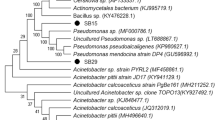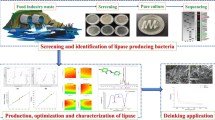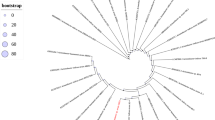Abstract
Lipases are important biocatalysts having the third largest global demand after amylases and proteases. In the present study, we have screened 56 potential lipolytic Pseudomonas strains for their lipolytic activity. Pseudomonas plecoglossicida S7 showed highest lipase production with specific activity of 70 U/mg. Statistical optimizations using Plackett Burman design and response surface methodology evaluated fourteen different media supplements including various oilcakes, carbon sources, nitrogen sources, and metal ions which led to a 2.23-fold (156.23 U/mg) increase in lipase activity. Further, inoculum size optimization increased the overall lipase activity by 2.81-folds. The lipase was active over a range of 30–50° C with a pH range (7–10). The enzyme was tolerant to various solvents like chloroform, methanol, 1-butanol, acetonitrile, and dichloromethane and retained 60% of its activity in the presence of sodium dodecyl sulfate (0.5% w/v). The enzyme was immobilized onto Ca-alginate beads which increased thermal (20–60 °C) and pH stability (5–10). The purified enzyme could successfully remove sesame oil stains and degraded upto 25.2% of diesel contaminated soil. These properties of the lipase will help in its applicability in detergent formulations, wastewater treatments, and biodegradation of oil in the environment.










Similar content being viewed by others
Data availability
The datasets used and/or analyzed during the current study are available from the corresponding author on reasonable request.
References
Acıkgoz-Erkaya I, Bayramoglu G, Akbulut A, Arica MY (2021) Immobilization of Candida rugosa lipase on magnetic biosilica particles: hydrolysis and transesterification studies. Biotechnol Bioprocess Eng 26:827–840
Ahmad FB, Zhang Z, Doherty WOS et al (2019) The prospect of microbial oil production and applications from oil palm biomass. Biochem Eng J 143:9–23. https://doi.org/10.1016/j.bej.2018.12.003
Al-Dhabi NA, Esmail GA, Ghilan AKM et al (2020) Isolation and screening of Streptomyces sp. Al-Dhabi-49 from the environment of Saudi Arabia with concomitant production of lipase and protease in submerged fermentation. Saudi J Biol Sci 27(1):474–479. https://doi.org/10.1016/j.sjbs.2019.11.011
Balaji L, Chittoor JT, Jayaraman G (2020) Optimization of extracellular lipase production by halotolerant Bacillus sp. VITL8 using factorial design and applicability of enzyme in pretreatment of food industry effluents. Prep Biochem Biotechnol 50(7):708–716. https://doi.org/10.1080/10826068.2020.1734936
Bayramoglu G, Akbulut A, Ozalp VC, Arica MY (2015) Immobilized lipase on micro-porous biosilica for enzymatic transesterification of algal oil. Chem Eng Res Des 95:12–21
Bayramoglu G, Celikbicak O, Kilic M, Arica MY (2022) Immobilization of Candida rugosa lipase on magnetic chitosan beads and application in flavor esters synthesis. Food Chem 366:130699
Bisht D, Yadav SK and Darmwal NS (2014) An oxidant and organic solvent tolerant alkaline lipase by P. aeruginosa mutant: downstream processing and biochemical characterization. Braz J Microbiol 44:1305–1314. https://doi.org/10.1590/S1517-83822013000400040
Bradford MM (1976) A rapid and sensitive method for the quantitation of microgram quantities of protein utilizing the principle of protein-dye binding. Anal Biochem 72:248–254
Brooks ST, Jabour J, Sharman AJ, Bergstrom DM (2018) An analysis of environmental incidents for a national Antarctic program. J Environ Manage 212:340–348
Chakdar H, Kumar M, Pandiyan K et al (2016) Bacterial xylanases: biology to biotechnology. 3 Biotech 6(2):150. https://doi.org/10.1007/s13205-016-0457-z
Chandra P, Enespa SR, Arora PK (2020) Microbial lipases and their industrial applications: A comprehensive review. Microb Cell Fact 19:169. https://doi.org/10.1186/s12934-020-01428-8
Choo DW, Kurihara T, Suzuki T et al (1998) A cold-adapted lipase of an Alaskan psychrotroph, Pseudomonas sp. strain B11–1: gene cloning and enzyme purification and characterization. Appl Environ Microbiol 64(2):486–497. https://doi.org/10.1128/aem.64.2.486-491.1998
Coelho ALS, Orlandelli RC (2020) Immobilized microbial lipases in the food industry: a systematic literature review. Crit Rev Food Sci Nutr 1–15. https://doi.org/10.1080/10408398.2020.1764489
Curci N, Strazzulli A, De Lise F et al (2019) Identification of a novel esterase from the thermophilic bacterium Geobacillus thermodenitrificans NG80-2. Extremophiles 23:407–419. https://doi.org/10.1007/s00792-019-01093-9
Das A, Shivakumar S, Bhattacharya S et al (2016) Purification and characterization of a surfactant-compatible lipase from Aspergillus tamarii JGIF06 exhibiting energy-efficient removal of oil stains from polycotton fabric. 3 Biotech 6:131. https://doi.org/10.1007/s13205-016-0449-z
de Azevedo WM, de Oliveira LFR, Alcântara MA et al (2020) Turning cacay butter and wheat bran into substrate for lipase production by Aspergillus terreus NRRL-255. Prep Biochem Biotechnol 50(7):689–696. https://doi.org/10.1080/10826068.2020.1728698
Devi R, Madhavan Nampoothiri K, Sukumaran RK et al (2020) Lipase of Pseudomonas guariconesis as an additive in laundry detergents and transesterification biocatalysts. J Basic Microbiol 60(2):112–125. https://doi.org/10.1002/jobm.201900326
Dumorné K, Córdova DC, Astorga-Eló M et al (2017) Extremozymes: a potential source for industrial applications. J Microbiol Biotechnol. https://doi.org/10.4014/jmb.1611.11006
Federici F, Fava F, Kalogerakis N et al (2009) Valorisation of agro-industrial by-products, effluents and waste: concept, opportunities and the case of olive mill waste waters. J Chem Technol Biotechnol 84(6):895–900. https://doi.org/10.1002/jctb.2165
Gazali FM, Suwastika IN (2018) Thermostable α-Amylase activity from thermophilic bacteria isolated from Bora Hot Spring, Central Sulawesi, In: Journal of Physics: Conference Series. The 2nd International Conference on Science (ICOS), Makassar, Indonesia. 979: 012001 https://doi.org/10.1088/1742-6596/979/1/012001
Geetha SJ, Al-Bahry S, Al-Wahaibi Y et al (2020) Recent update on biodiesel production using various substrates and practical execution. In: Srivastava N, Srivastava M, Mishra P, Gupta V (eds) Substrate Analysis for Effective Biofuels Production. Clean Energy Production Technologies. Springer, Singapore. https://doi.org/10.1007/978-981-32-9607-7_5
Hu J, Cai W, Wang C et al (2018) Purification and characterization of alkaline lipase production by Pseudomonas aeruginosa HFE733 and application for biodegradation in food wastewater treatment. Biotechnol Biotechnol Equip. https://doi.org/10.1080/13102818.2018.1446764
Ilesanmi OI, Adekunle AE, Omolaiye JA, et al (2020) Isolation, optimization and molecular characterization of lipase producing bacteria from contaminated soil.Scientific African 8:p.e00279. https://doi.org/10.1016/j.sciaf.2020.e00279
Jain R, Pandey N, Pandey A (2020) Aggregation properties of cold-active lipase produced by a psychrotolerant strain of Pseudomonas palleroniana (GBPI_508). Biocatal Biotransformation 38(4):263–273. https://doi.org/10.1080/10242422.2019.1666829
Kezrane I, Harouna BM, Hamadache M et al (2020) Use of hydrocarbons sludge as a substrate for the production of biosurfactants by Pseudomonas aeruginosa ATCC 27853. Environ Monit Assess 192:1–16. https://doi.org/10.1007/s10661-020-08269-3
Komesli S, Akbulut S, Arslan NP et al (2020) Waste frying oil hydrolysis and lipase production by cold-adapted Pseudomonas yamanorum LP2 under non-sterile culture conditions. Environ Technol 1-9https://doi.org/10.1080/09593330.2020.1745297
Klibanov AM (2001) Improving enzymes by using them in organic solvents. Nature 409:241–246. https://doi.org/10.1038/35051719
Laemmli UK (1970) Cleavage of structural proteins during the assembly of the head of bacteriophage T4. Nature 227(5259):680–685. https://doi.org/10.1038/227680a0
Marín-Suárez M, Méndez-Mateos D, Guadix A, Guadix EM (2019) Reuse of immobilized lipases in the transesterification of waste fish oil for the production of biodiesel. Renew Energy 140:1–8
Mehta A, Grover C, Gupta R (2018) Purification of lipase from Aspergillus fumigatus using Octyl Sepharose column chromatography and its characterization. J Basic Microbiol 58(10):857–866. https://doi.org/10.1002/jobm.201800129
Mesa M, Pereañez JA, Preciado LM, Bernal C (2018) How the Triton X-100 modulates the activity/stability of the Thermomyces lanuginose lipase: insights from experimental and molecular docking approaches. Int J Biol Macromol 120(Pt B):2410–2417. https://doi.org/10.1016/j.ijbiomac.2018.09.009
Musa H, Hafiz Kasim F, Nagoor Gunny AA et al (2019) Enhanced halophilic lipase secretion by Marinobacter litoralis SW-45 and its potential fatty acid esters release. J Basic Microbiol 59(1):87–100. https://doi.org/10.1002/jobm.201800382
Nema A, Patnala SH, Mandari V et al (2019) Production and optimization of lipase using Aspergillus niger MTCC 872 by solid-state fermentation. Bull Natl Res Cent 43:82. https://doi.org/10.1186/s42269-019-0125-7
Nathan VK, Rani ME (2020) A cleaner process of deinking waste paper pulp using Pseudomonas mendocina ED9 lipase supplemented enzyme cocktail. Environ Sci Pollut Res 27:36498–36509. https://doi.org/10.1007/s11356-020-09641-z
Ogino C, Amoah J (2019) Energy production: biodiesel. In: Ueda M (eds) Yeast Cell Surface Engineering. Springer, Singapore. pp. 43–61. https://doi.org/10.1007/978-981-13-5868-5_4
Paggiola G, Derrien N, Moseley JD et al (2020) Application of bio-based solvents for biocatalysed synthesis of amides with Pseudomonas stutzeri lipase (PSL). Pure Appl Chem 92(4):579–586
da Pereira AS, Diniz MM, De Jong G et al (2019) Chitosan-alginate beads as encapsulating agents for Yarrowia lipolytica lipase: morphological, physico-chemical and kinetic characteristics. Int J Biol Macromol 139:61–630. https://doi.org/10.1016/j.ijbiomac.2019.08.009
Perna RF, Tiosso PC, Sgobi LM et al (2017) Effects of Triton X-100 and PEG on the catalytic properties and thermal stability of lipase from free and immobilized on glyoxyl-agarose. Open Biochem J 11:66–76. https://doi.org/10.2174/1874091x01711010066
Phukon LC, Chourasia R, Kumari M et al (2020) Production and characterisation of lipase for application in detergent industry from a novel Pseudomonas helmanticensis HS6. Bioresour Technol 309:123352. https://doi.org/10.1016/j.biortech.2020.123352
dos Prazeres JN, Cruz JAB, Pastore GM (2006) Characterization of alkaline lipase from Fusarium oxysporum and the effect of different surfactants and detergents on the enzyme activity. Braz J Microbiol 37:505–509. https://doi.org/10.1590/S1517-83822006000400019
Priyanka P, Tan Y, Kinsella GK et al (2019) Solvent stable microbial lipases: current understanding and biotechnological applications. Biotechnol Lett 41:203–220. https://doi.org/10.1007/s10529-018-02633-7
Priyanka P, Kinsella GK, Henehan GT et al (2020) Isolation and characterization of a novel thermo-solvent-stable lipase from Pseudomonas brenneri and its application in biodiesel synthesis. Biocatal Agric Biotechnol 29:101806. https://doi.org/10.1016/j.bcab.2020.101806
Putri DN, Khootama A, Perdani MS et al (2020) Optimization of Aspergillus niger lipase production by solid state fermentation of agro-industrial waste. Energy Rep 6(Supplement 1):331–335. https://doi.org/10.1016/j.egyr.2019.08.064
Ramani K, Chockalingam E, Sekaran G (2010) Production of a novel extracellular acidic lipase from Pseudomonas gessardii using slaughterhouse waste as a substrate. J Ind Microbiol Biotechnol 37(5):531–535. https://doi.org/10.1007/s10295-010-0700-2
Rios NS, Arana-Peña S, Mendez-Sanchez C et al (2019a) Reuse of lipase from Pseudomonas fluorescens via its step-by-step coimmobilization on glyoxyl-octyl agarose beads with least stable lipases. Catalysts 9(5):487. https://doi.org/10.3390/catal9050487
Rios NS, Mendez-Sanchez C, Arana-Peña S et al (2019b) (2019b) Immobilization of lipase from Pseudomonas fluorescens on glyoxyl-octyl-agarose beads: improved stability And reusability. Biochim Biophys Acta - Proteins Proteomics 1867(9):741–747. https://doi.org/10.1016/j.bbapap.2019.06.005
Rocha e Silva NMP, Rufino RD, Luna JM et al (2014) Screening of Pseudomonas species for biosurfactant production using low-cost substrates. Biocatal Agric Biotechnol 3(2):132–139. https://doi.org/10.1016/j.bcab.2013.09.005
Sahoo RK, Das A, Gaur M et al (2020) Parameter optimization for thermostable lipase production and performance evaluation as prospective detergent additive. Prep Biochem Biotechnol 50(6):578–584. https://doi.org/10.1080/10826068.2020.1719513
Sahay S, Chouhan D (2018) Study on the potential of cold-active lipases from psychrotrophic fungi for detergent formulation. J Genet Eng Biotechnol 16(2):319–325. https://doi.org/10.1016/j.jgeb.2018.04.006
Salwoom L, Rahman RNZRA, Salleh AB et al (2019) Isolation, characterisation, and lipase production of a cold-adapted bacterial strain Pseudomonas sp. LSK25 isolated from Signy Island. Antarctica. Molecules. 24(4):715. https://doi.org/10.3390/molecules24040715
Sierra G (1957) A simple method for the detection of lipolytic activity of micro-organisms and some observations on the influence of the contact between cells and fatty substrates. Antonie Van Leeuwenhoek 23:15–22. https://doi.org/10.1007/BF02545855
Sooch BS, Kauldhar BS (2013) Influence of multiple bioprocess parameters on production of lipase from Pseudomonas sp. BWS-5. Brazilian Arch Biol Technol 56(5):711–721. https://doi.org/10.1590/S1516-89132013000500002
Sonkar K, Singh DP (2020) Biochemical characterization and thermodynamic study of lipase from psychrotolerant Pseudomonas punonensis. Biocatal Agric Biotechnol 28:101686. https://doi.org/10.1016/j.bcab.2020.101686
SPSS (2007) SPSS for windows version 16.0 SPSS Inc. Chicago
Sharma A, Kumar P, Rehman MB (2014) Biodegradation of diesel hydrocarbon in soil by bioaugmentation of Pseudomonas aeruginosa: a laboratory scale study. Int J Env Bioremediat Biodegrad 2:202–212
Velasco-Lozano S (2020) Immobilization of enzymes as cross-linked enzyme aggregates: general strategy to obtain robust biocatalysts. Methods in Mol Bio 2100:345–361. https://doi.org/10.1007/978-1-0716-0215-7_23
Verma N, Dollinger P, Kovacic F et al (2020) The membrane integrated steric chaperone Lif facilitates active site opening of Pseudomonas aeruginosa lipase A. J Comput Chem 41:500–512. https://doi.org/10.1002/jcc.26085
Yele VU, Desai K (2014) A New thermostable and organic solvent-tolerant lipase from Staphylococcus warneri; optimization of media and production conditions using statistical methods. Appl Biochem Biotechnol 175(2):855–869. https://doi.org/10.1007/s12010-014-1331-2
Zakaria NN, Gomez-Fuentes C, Abdul Khalil K et al (2021) Statistical optimisation of diesel biodegradation at low temperatures by an Antarctic marine bacterial consortium isolated from non-contaminated seawater. Microorganisms 9:1213
Funding
The authors received from to ICAR-NBAIM, Mau, financial assistance and infrastructural facilities.
Author information
Authors and Affiliations
Contributions
HC conceptualized the study, edited, and revised the manuscript. PC executed all experimental part and prepared the first draft of the manuscript. SV helped in screening of lipolytic Pseudomonads. PC and SV compiled all experimental results. AB designed the statistical set up for the experiments and analyzed the statistical data. HC, SS, and AKS finalized the manuscript in its final form.
Corresponding author
Ethics declarations
Ethics approval and consent to participate
Not applicable.
Consent for publication
Not applicable.
Competing interests
The authors declare competing interests.
Disclaimer
This is a part of the Ph.D. work of the first author under supervision of the corresponding author as co-supervisor.
Additional information
Responsible Editor: Gerald Thouand
Publisher's note
Springer Nature remains neutral with regard to jurisdictional claims in published maps and institutional affiliations.
Supplementary Information
Below is the link to the electronic supplementary material.
Rights and permissions
Springer Nature or its licensor holds exclusive rights to this article under a publishing agreement with the author(s) or other rightsholder(s); author self-archiving of the accepted manuscript version of this article is solely governed by the terms of such publishing agreement and applicable law.
About this article
Cite this article
Choudhary, P., Bhowmik, A., Verma, S. et al. Multi-substrate sequential optimization, characterization and immobilization of lipase produced by Pseudomonas plecoglossicida S7. Environ Sci Pollut Res 30, 4555–4569 (2023). https://doi.org/10.1007/s11356-022-22098-6
Received:
Accepted:
Published:
Issue Date:
DOI: https://doi.org/10.1007/s11356-022-22098-6




